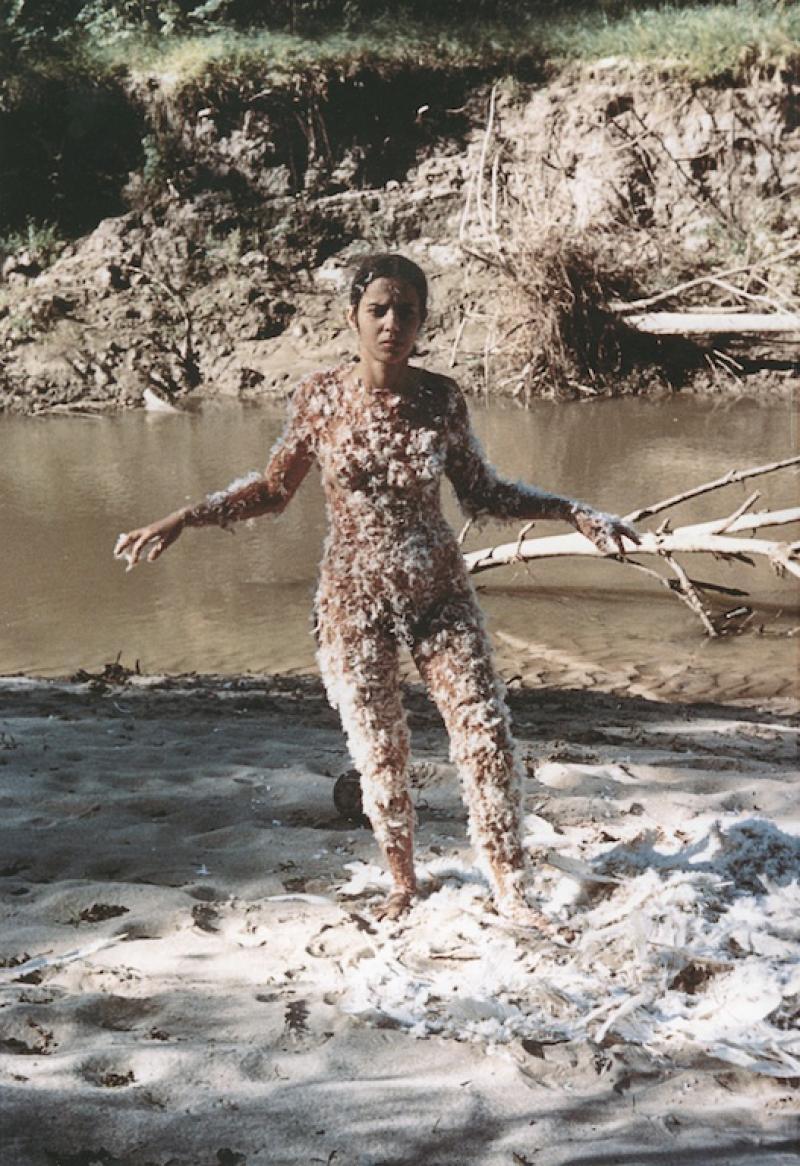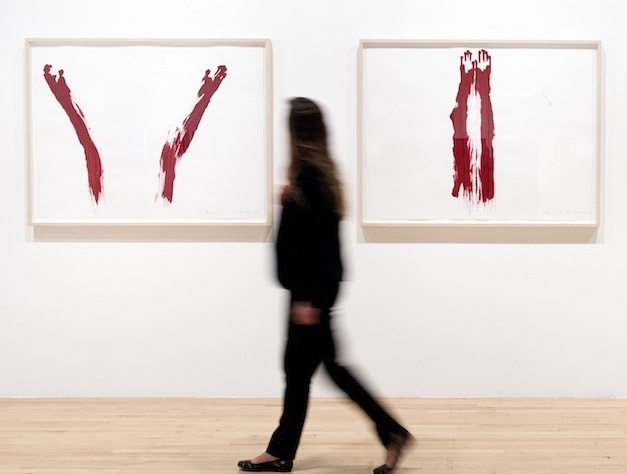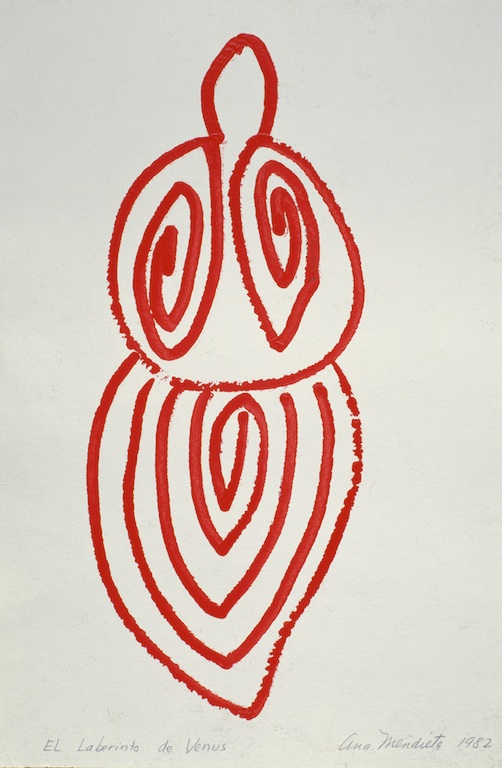Ana Mendieta: Traces, Hayward Gallery | reviews, news & interviews
Ana Mendieta: Traces, Hayward Gallery
Ana Mendieta: Traces, Hayward Gallery
A life cut short before its amazing promise could be fully realised

Gazing out of my window pondering how to start my review of Ana Mendieta, I noticed a creeper engulfing the house at the end of my garden. Having covered the wall, one window and a chimney, the tentacles are spreading along the gutter and over the roof. Meanwhile, my neighbour’s roses have encroached six feet into my territory and, next door the other way, a vine is assiduously working its way along the hedge and into the branches of a tree.
What struck Mendieta when she visited the archaeological site of Yagul in Mexico, in 1973, was the vegetation engulfing the ruins of the Pre-Columbian city. “It was nature’s reclaiming of this thing, this site”, she recalled, “taking over.” The experience prompted a turning point in her work. Having bought some flowers in the nearby market, she lay down in an open grave and asked her partner, Hans Breder, to cover her naked body with the flowers. “The way I really thought about it”, she added, “was having nature take over the body the same way it had taken over these symbols of past civilisations.”
 Image from Yagul, 1973, is one of many photographs taken during the Seventies that record Mendieta lying on the ground in some remote spot as though she were a corpse gradually sinking into and merging with the soil. The impulse was not an obsession with death so much as the desire to blend with nature and the elements. For her, the earth was like a mother in whom she sought refuge and, in photographs, her shrouded or mummified form appears lying on the ground, sinking into sand or mud, and being engulfed by water. She also drew the outline of her body in earth, sand and rock; blood puddles inside its contours; gunpowder fills it with smouldering ashes; flames etch the image into grass or wood (pictured above: Silueta Series, 1977) and fireworks create a sparkling effigy silhouetted against the night sky. The feelings of displacement she was trying to ameliorate originated in childhood.
Image from Yagul, 1973, is one of many photographs taken during the Seventies that record Mendieta lying on the ground in some remote spot as though she were a corpse gradually sinking into and merging with the soil. The impulse was not an obsession with death so much as the desire to blend with nature and the elements. For her, the earth was like a mother in whom she sought refuge and, in photographs, her shrouded or mummified form appears lying on the ground, sinking into sand or mud, and being engulfed by water. She also drew the outline of her body in earth, sand and rock; blood puddles inside its contours; gunpowder fills it with smouldering ashes; flames etch the image into grass or wood (pictured above: Silueta Series, 1977) and fireworks create a sparkling effigy silhouetted against the night sky. The feelings of displacement she was trying to ameliorate originated in childhood.
Mendieta was born in Cuba in 1948. Her father, who actively opposed Fidel Castro’s Communist regime, sent his two daughters to the States for safety; they were later joined by their mother and settled in Iowa. The 12-year-old Ana badly missed her homeland and felt estranged and alienated. As a student at Iowa University, she made a series of photographs in which she tries to establish a new identity by disguising herself with wigs, make-up and stocking masks or glueing facial hair to her upper lip and chin to simulate a fine beard.
In 1973, the rape and murder of a student nurse prompted Mendieta to stage a re-enactment of the crime in her apartment and invite male students to witness the horrifying scene. This was followed by Rape (1973), an outdoor tableau in which she posed as a blood-splattered murder victim half buried in undergrowth. (These early pieces must surely have influenced Cindy Sherman, well-known for enacting B movie stills and simulating crime scenes).
 Mendieta created numerous visceral works using blood to suggest martyrdom or sacrifice. Untitled, 1973, which shows her lying beneath a blood stained sheet with an ox heart on her chest, evokes the gruesome sacrifices for which the Aztecs are famous. Other works are more subtle; in the film Sweating Blood,1973, her Buddha-like serenity remains intact, despite the blood trickling down her forehead over her closed eyes. Dipping her arms in blood and pressing them against sheets of paper or the wall, she created Body Tracks by gradually sliding towards to the floor. The red smears resemble Yves Klein’s Anthropometries, except that they are angrier and more violent than the elegant blue smudges made by Klein's models.
Mendieta created numerous visceral works using blood to suggest martyrdom or sacrifice. Untitled, 1973, which shows her lying beneath a blood stained sheet with an ox heart on her chest, evokes the gruesome sacrifices for which the Aztecs are famous. Other works are more subtle; in the film Sweating Blood,1973, her Buddha-like serenity remains intact, despite the blood trickling down her forehead over her closed eyes. Dipping her arms in blood and pressing them against sheets of paper or the wall, she created Body Tracks by gradually sliding towards to the floor. The red smears resemble Yves Klein’s Anthropometries, except that they are angrier and more violent than the elegant blue smudges made by Klein's models.
Memories of santeria, a fusion of Catholicism and African religions still practiced in Cuba today, permeate many of these performances. The black candles used in rituals by the Abakua, an Afro-Cuban sect that excludes women, create the burning outline of a prone body. Some also evoke voodoo; on film we see a white cockerel being sacrificed and a woman being covered in feathers until she resembles a giant bird.
 In search of solace from the isolation she felt in the States surrounded by white male artists, Mendieta had begun researching Pre-Columbian and other so-called primitive belief systems. The undercurrents of magic, ritual, dread and superstition that infiltrated her work sets it apart from earth art, performance art, Viennese Aktionism and other styles and isms that superficially resemble it. But this distinctive flavour also made it unpalatable to those attuned to the clean geometry of minimalism or the analytic approach of conceptualism and she remained a voice apart. Ironically, she later married the minimalist sculptor Carl Andre.
In search of solace from the isolation she felt in the States surrounded by white male artists, Mendieta had begun researching Pre-Columbian and other so-called primitive belief systems. The undercurrents of magic, ritual, dread and superstition that infiltrated her work sets it apart from earth art, performance art, Viennese Aktionism and other styles and isms that superficially resemble it. But this distinctive flavour also made it unpalatable to those attuned to the clean geometry of minimalism or the analytic approach of conceptualism and she remained a voice apart. Ironically, she later married the minimalist sculptor Carl Andre.
When she was finally able to return to Cuba, she immediately felt at home and this prompted another shift in her work. In 1981, on the limestone walls of two caves in the Jaruco National Park, she carved a series of simplified female figures and named them after goddesses of the indigenous Taino people who once inhabited the island. She also began making marvellously spirited drawings (pictured above right: Labyrinth of Venus, 1985) using simplified female forms inspired by cave paintings and sculptures such as the Venus of Willendorf, dating back more than 24,000 years.
This was the beginning of a glorious period of exploration which involved drawing on leaves, making sculptures out of mud and burning totemic shapes into lengths of wood. But it was cut short when, in 1985, Mendieta fell from the window of the 34th-floor apartment she shared with Andre in New York. She was 37 when she died, the age at which Louise Bourgeois began her first forays into sculpture with her totemic wooden figures. There are striking similarities in the work of the two women and had Mendieta been able to continue like Bourgeois for another 60 years who knows what she might have achieved.
- Ana Mendieta: Traces at the Hayward Gallery until 15 December
Explore topics
Share this article
The future of Arts Journalism
You can stop theartsdesk.com closing!
We urgently need financing to survive. Our fundraising drive has thus far raised £49,000 but we need to reach £100,000 or we will be forced to close. Please contribute here: https://gofund.me/c3f6033d
And if you can forward this information to anyone who might assist, we’d be grateful.

Subscribe to theartsdesk.com
Thank you for continuing to read our work on theartsdesk.com. For unlimited access to every article in its entirety, including our archive of more than 15,000 pieces, we're asking for £5 per month or £40 per year. We feel it's a very good deal, and hope you do too.
To take a subscription now simply click here.
And if you're looking for that extra gift for a friend or family member, why not treat them to a theartsdesk.com gift subscription?
more Visual arts
 'We are bowled over!' Thank you for your messages of love and support
Much-appreciated words of commendation from readers and the cultural community
'We are bowled over!' Thank you for your messages of love and support
Much-appreciated words of commendation from readers and the cultural community
 Photo Oxford 2025 review - photography all over the town
At last, a UK festival that takes photography seriously
Photo Oxford 2025 review - photography all over the town
At last, a UK festival that takes photography seriously
![SEX MONEY RACE RELIGION [2016] by Gilbert and George. Installation shot of Gilbert & George 21ST CENTURY PICTURES Hayward Gallery](https://theartsdesk.com/sites/default/files/styles/thumbnail/public/mastimages/Gilbert%20%26%20George_%2021ST%20CENTURY%20PICTURES.%20SEX%20MONEY%20RACE%20RELIGION%20%5B2016%5D.%20Photo_%20Mark%20Blower.%20Courtesy%20of%20the%20Gilbert%20%26%20George%20and%20the%20Hayward%20Gallery._0.jpg?itok=7tVsLyR-) Gilbert & George, 21st Century Pictures, Hayward Gallery review - brash, bright and not so beautiful
The couple's coloured photomontages shout louder than ever, causing sensory overload
Gilbert & George, 21st Century Pictures, Hayward Gallery review - brash, bright and not so beautiful
The couple's coloured photomontages shout louder than ever, causing sensory overload
 Lee Miller, Tate Britain review - an extraordinary career that remains an enigma
Fashion photographer, artist or war reporter; will the real Lee Miller please step forward?
Lee Miller, Tate Britain review - an extraordinary career that remains an enigma
Fashion photographer, artist or war reporter; will the real Lee Miller please step forward?
 Kerry James Marshall: The Histories, Royal Academy review - a triumphant celebration of blackness
Room after room of glorious paintings
Kerry James Marshall: The Histories, Royal Academy review - a triumphant celebration of blackness
Room after room of glorious paintings
 Folkestone Triennial 2025 - landscape, seascape, art lovers' escape
Locally rooted festival brings home many but not all global concerns
Folkestone Triennial 2025 - landscape, seascape, art lovers' escape
Locally rooted festival brings home many but not all global concerns
 Sir Brian Clarke (1953-2025) - a personal tribute
Remembering an artist with a gift for the transcendent
Sir Brian Clarke (1953-2025) - a personal tribute
Remembering an artist with a gift for the transcendent
 Emily Kam Kngwarray, Tate Modern review - glimpses of another world
Pictures that are an affirmation of belonging
Emily Kam Kngwarray, Tate Modern review - glimpses of another world
Pictures that are an affirmation of belonging
 Kiefer / Van Gogh, Royal Academy review - a pairing of opposites
Small scale intensity meets large scale melodrama
Kiefer / Van Gogh, Royal Academy review - a pairing of opposites
Small scale intensity meets large scale melodrama
 Jenny Saville: The Anatomy of Painting, National Portrait Gallery review - a protégé losing her way
A brilliant painter in search of a worthwhile subject
Jenny Saville: The Anatomy of Painting, National Portrait Gallery review - a protégé losing her way
A brilliant painter in search of a worthwhile subject
 Abstract Erotic, Courtauld Gallery review - sculpture that is sensuous, funny and subversive
Testing the boundaries of good taste, and winning
Abstract Erotic, Courtauld Gallery review - sculpture that is sensuous, funny and subversive
Testing the boundaries of good taste, and winning
 Edward Burra, Tate Britain review - watercolour made mainstream
Social satire with a nasty bite
Edward Burra, Tate Britain review - watercolour made mainstream
Social satire with a nasty bite

Add comment